In 2016, citizen media plays a crucial role in almost every breaking news story around the world. It is increasingly rare that a news event will go by without a picture or video from an eyewitness at the scene.
One well-documented trend has been the way journalists contact eyewitnesses in the moments that follow them posting their photo, video or tweet online. Much has been written on the ethical challenges this poses and the best practices for contacting eyewitnesses.
Increasingly, observers are noting the threat to the sustainability of social newsgathering posed by egregious repeated missteps in this space.
When you have content that news orgs want… Few individuals did anything wrong but together we *must* do better. pic.twitter.com/QPPc42wlq4
— Fergus Bell (@fergb) July 8, 2016
There are many angles from which we can start to address this challenge, and in this article I want to start with what, to my mind, should be the most simple: avoiding multiple requests from a single news organization. That’s right – it’s not uncommon for eyewitnesses to be bombarded by multiple requests from a single newsroom.
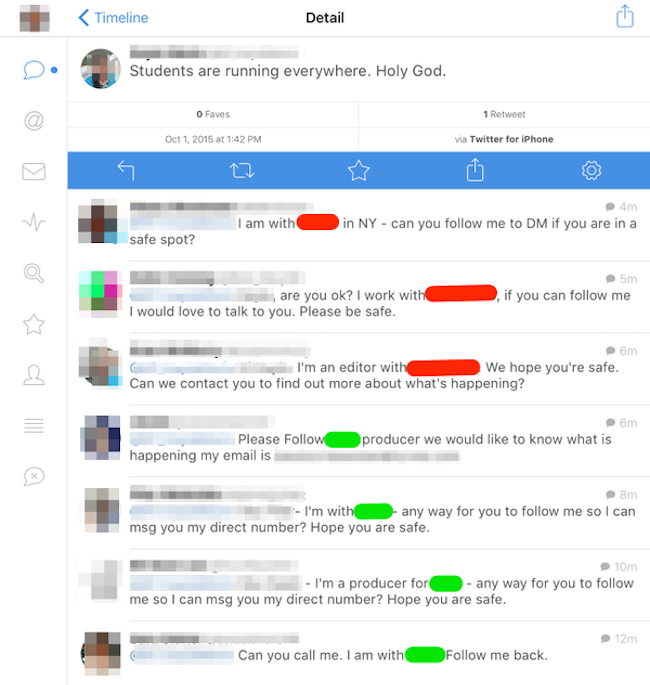
The above screenshot shows reporters contacting a witness to the Umpqua Community College shooting in October 2015: seven requests from seven different journalists representing only two high profile news organisations (red and green). Later the same day, that source tweeted:
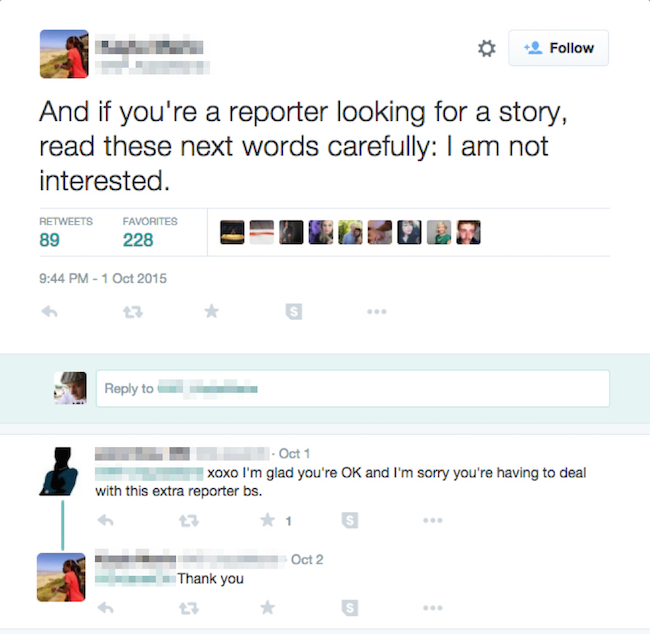
This pattern is repeated after events such as Dallas, and made worse in the US in particular by repeated requests both from national networks and all their affiliate stations.
Analysing requests for one video from the recent shooting of policemen in Dallas, five networks (and their affiliates) made 43 separate requests (either for permission or interview), with the worst offending network making 14 separate requests. For one video.
To be blunt: as an industry we have to do better. This isn’t only to protect eyewitnesses or the sustainability of social newsgathering, it’s also about avoiding duplicate work and – on an even more fundamental level – having processes and workflows in place for handling eyewitness media.
Here are a some quick, easy ways to do this better, using simple tools you might be familiar with.
Google Sheets FTW
Detecting duplicates in Google Sheets is pretty straightforward – and if you’re not much into =FORMULA() jamming, then we’ve made a helpful free template: bit.ly/UGCtemplate
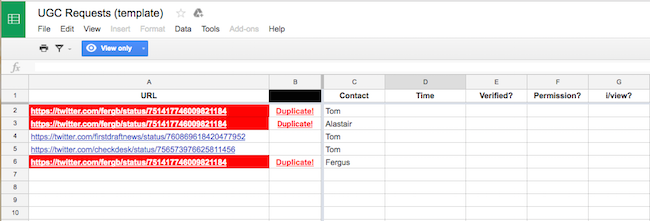
This is elegantly simple:
- Share the sheet (and this workflow) with anyone who might touch eyewitness media in your organization or network
- When a story breaks duplicate the sheet
- When you find some eyewitness media you want to verify or seek permissions for, take a second to copy and paste the URL to the sheet in the “URL” column. It only takes a second.
- If someone’s already added that link – it’ll flash red and say “Duplicate!” in the adjacent cell (both on your cell and on the previous entry of that URL)
- If it doesn’t flash red then add your name under “Point of Contact”, the time you’re adding the link under “Time”, and update the row when you’ve verified and reached out for permission or interview
If you’re a Google Sheets whizz, you can also run scripts that will automatically complete the “Contact” and “Timestamp” fields.
Hacking Slack
Slack is a powerful tool for newsroom collaboration, and there’s a fair chance you’re already using it to communicate about daily work (or just to spam your colleagues with GIFs).
It can also provide a really simple way to check if your colleagues have already sent out a permissions or interview request to a source on social media. Here’s how:
- Set up a #ugc-requests channel
- Whenever you’re about to start working on a piece of content (either verifying, or contacting for permissions) – search the URL in Slack’s search bar
- If a result is returned and shows the link has been added to #ugc-requests, then move on. Don’t contact that source.
- If no result is returned, then add your URL to the #ugc-requests and contact the source.
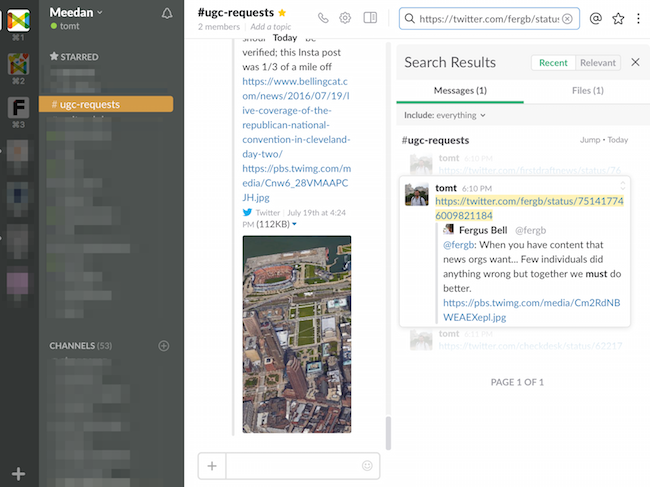
In this case, I won’t contact Fergus as someone has already added the link to the Slack channel. If nobody had added this URL, Slack would return no search results and we’d be good to go!
As with all of these workflows, they only work to the extent that everyone on a team is using them, which may not be straightforward if we also wanted to solve the inefficient process that extends beyond newsrooms to affiliates and individual show teams.
However, it only takes one Slack channel (or one Google Sheet, or one Checkdesk) and an adoption of an agreed workflow, and we could see a dramatic reduction in the amount of duplicated work right away.
Check it with Checkdesk
When we implemented duplicate detection on Checkdesk, it was to avoid duplicate verification work rather than as a way to avoid duplicate permissions requests. But guess what: they’re basically the same thing. Even crafting a tweet to reach out to a source that your colleague has already contacted is a waste of your time and it can make you look bad in full public view.
Whenever you add a report to Checkdesk for your team to work on, the system automatically scans the database for duplicates, and provides the Checkdesk link, as shown below.
This not only helps you avoid damaging and inefficient repeated requests, but it also gives a clear sense for what the status of that content is – Verified, False, In Progress etc – and any notes your colleagues may have left, providing an easy way for you to get involved in verifying the relevant media.
Limitations
These workflows aren’t without their limitations: most notably that it’s still likely eyewitnesses will receive requests from many, many journalists, as newsrooms continue in their pursuit of a competitive edge.
But recall those Dallas statistics for one video: 43 requests from 5 news organizations and affiliates. If that dropped to only one request from each of those news networks, that would represent almost a 90 per cent drop in requests.
Add that to all the time saved making duplicate requests (and going about verifying the content etc.) and all the negative public reaction to such egregious requests, and there’s a compelling argument for starting with simple workflow changes.
Follow First Draft on Twitter and Facebook for regular updates on social newsgathering, digital verification, best practice and more.



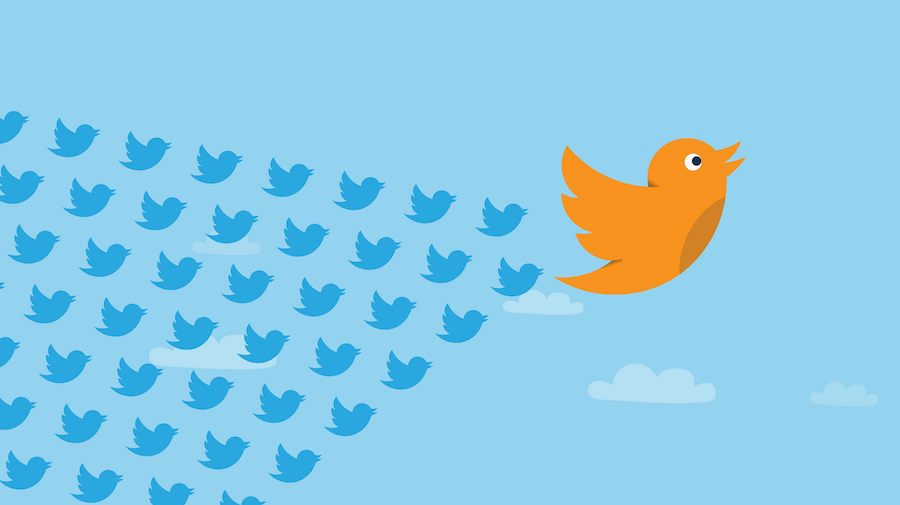
One thought on “‘Did you take that photo?’: Three ways to improve newsgathering on social media”